Word for Microsoft 365 Word 2021 Word 2019 Word 2016 Word 2013 Word 2010 Word 2007 More…Less
An index lists the terms and topics that are discussed in a document, along with the pages that they appear on. To create an index, you mark the index entries by providing the name of the main entry and the cross-reference in your document, and then you build the index.
You can create an index entry for an individual word, phrase, or symbol, for a topic that spans a range of pages, or that refers to another entry, such as «Transportation. See Bicycles.» When you select text and mark it as an index entry, Word adds a special XE (Index Entry) field that includes the marked main entry and any cross-reference information that you choose to include.

After you mark all the index entries, you choose an index design and build the finished index. Word collects the index entries, sorts them alphabetically, references their page numbers, finds and removes duplicate entries from the same page, and displays the index in the document.
Mark the entries
These steps show you how to mark words or phrases for your index, but you can also Mark index entries for text that spans a range of pages.
-
Select the text you’d like to use as an index entry, or just click where you want to insert the entry.
-
On the References tab, in the Index group, click Mark Entry.
-
You can edit the text in the Mark Index Entry dialog box.
-
You can add a second-level in the Subentry box. If you need a third level, follow the subentry text with a colon.
-
To create a cross-reference to another entry, click Cross-reference under Options, and then type the text for the other entry in the box.
-
To format the page numbers that will appear in the index, select the Bold check box or Italic check box below Page number format.
-
-
Click Mark to mark the index entry. To mark this text everywhere it shows up in the document, click Mark All.
-
To mark additional index entries, select the text, click in the Mark Index Entry dialog box, and then repeat steps 3 and 4.
Create the index
After you mark the entries, you’re ready to insert the index into your document.
-
Click where you want to add the index.
-
On the References tab, in the Index group, click Insert Index.
-
In the Index dialog box, you can choose the format for text entries, page numbers, tabs, and leader characters.
-
You can change the overall look of the index by choosing from the Formats dropdown menu. A preview is displayed in the window to the top left.
-
Click OK.
Edit or format an index entry and update the index
If you mark more entries after creating your index, you’ll need to update the index to see them.
-
If you don’t see the XE fields, click Show/Hide
in the Paragraph group on the Home tab.
-
Find the XE field for the entry that you want to change, for example, { XE «Callisto» t «See Moons» }.
-
To edit or format an index entry, change the text inside the quotation marks.
-
To update the index, click the index, and then press F9. Or click Update Index in the Index group on the References tab.
If you find an error in the index, locate the index entry that you want to change, make the change, and then update the index.
Delete an index entry and update the index
-
Select the entire index entry field, including the braces ({}), and then press DELETE.
If you don’t see the XE fields, click Show/Hide
in the Paragraph group on the Home tab.
-
To update the index, click the index, and then press F9. Or click Update Index in the Index group on the References tab.
Need more help?
Want more options?
Explore subscription benefits, browse training courses, learn how to secure your device, and more.
Communities help you ask and answer questions, give feedback, and hear from experts with rich knowledge.
Download Article
Download Article
- Marking Your Entries
- Inserting the Index Page
- Editing Index Entries
- Video
- Q&A
- Tips
|
|
|
|
|
This wikiHow teaches you how to build an index page for your Microsoft Word document. Microsoft Word comes with a built-in indexing tool that can automatically create an index based on the entries you choose. All you’ll need to do is use the Mark Entry tool to mark each word or phrase you want to add to the index. Terms in your index can point to specific pages in the document or cross-reference to other indexed entries.
-
1
Open a Microsoft Word document. MS Word lets you add an index to any document regardless of its length, style, or subject matter. Before you can add an index to your document, you’ll need to go through each page to mark the terms you want to appear in the index.
-
2
Select a word or a group of words for your index. You can select a word or phrase by highlighting it with your mouse.
Advertisement
-
3
Click the References tab. It’s on the toolbar at the top of Word.
-
4
Click the Mark Entry button. Depending on your version of word, this icon will usually appear in a panel on the toolbar labeled «Index.» It’s the icon of a sheet of paper with a minus sign and a plus sign.[1]
-
5
Change how the word or phrase appears in the index. You’ll see the word or phrase you selected in the «Main entry» field at the top of the window. As of now, this is how that word or phrase will appear in the index you’ll be creating. If you want to change the wording, capitalization, or other parameters, you can do so by editing the text in the «Main entry» box.
- If you want to adjust the font face, size, style, or color of this entry in your index, you can do so here. Just highlight the word or phrase in «Main entry,» right-click the highlighted area, and then select Font. Make any changes you want to the font and then click OK.
-
6
Add a subentry (optional). Think about main entries as being their own lines in your index. A subentry would appear below its main entry in the index. It might be helpful to go through your document and create main entries first, and then go back and add subentries.
- For example, if you selected the word surnames and plan to index all surnames in your document, you may want to add mark each surname in the document with the «Surnames» main entry, and then list the surname itself as the subentry.
- You could also add a third-level entry, which would appear below a subentry in the index. To do this, just type a colon after the subentry and then type the third-level entry.
-
7
Choose the location referenced in the index entry. When Word builds an index based on your marked entries, it will simply list the page number on the entry you selected by default. For example, if you highlighted the word «Surnames» on page 2, the index will list «page 2» as the location of the Surnames entry. This is because «Current page» is the default selection in the «Options» section.
- If you’d rather the selected entry reference a different entry (think of when you see «See also» in an index), select «Cross-reference,» and then type the name of the other entry next to «See.»
- If you want the entry to point to a range of pages rather than a single page, you’ll need to create a bookmark for that page range. If you have a bookmark, select «Page range,» and then select your bookmark from the drop-down menu.
-
8
Format the page numbers in your index. Under the «Page number format»‘ heading, choose whether to display the page numbers in Bold and/or Italics as needed.
-
9
Click Mark to save your new entry. This button will mark the highlighted term and add it to your index with its corresponding page number, range, or cross-reference.
- After marking an entry in the index, paragraph markers will turn on immediately, and you’ll see the selected word or phrase in your document surrounded in curly braces with special formatting, much like this:
{XE "entry"} - If it’s too confusing for you to see your document in this format, you can switch back to the standard view by clicking the Home tab and then clicking the paragraph symbol ¶ in the toolbar.
- If you want to mark all instances of the same word or phrase throughout your document, you can click the Mark all button at the bottom. This would add the page number for all instances of this word or phrase to its entry in the index.
- After marking an entry in the index, paragraph markers will turn on immediately, and you’ll see the selected word or phrase in your document surrounded in curly braces with special formatting, much like this:
-
10
Continue marking entries. The «Mark Index Entry» window stays open after you mark an entry, which makes it easy to move to the next entry you want to mark. To continue, highlight another term in your document, and then click the «Mark Index Entry» window to add it to the «Main entry» field. After customizing this entry to your liking, click Mark to save it and move to the next.
- After marking your main entries, go through and mark any subentries or third-level entries. It’s kind of awkward to do:
- Highlight the word or phrase you want to list as a subentry. Using our surname example, let’s say you created a main entry for Surnames and want to add the surname «Williams» to the list of surnames in the index. Start by highlighting the first instance of «Williams» in your document.
- Next, click the Mark Index Entry window. This adds «Williams» to the «Main entry» field (for now).
- Type or paste the subentry (Williams, in our example) into the subentry field.
- Replace the text in the «Main entry» field with the name of the main entry (Surnames, in our example).
- Edit any details and click Mark (or Mark all).
- After marking your main entries, go through and mark any subentries or third-level entries. It’s kind of awkward to do:
Advertisement
-
1
Click your mouse cursor where you want to place the index. In most cases, you’ll want to place your index at the end of the document—just scroll down and click the first empty line below your existing content.
-
2
Click the Insert tab. It’s at the top of Word.
-
3
Insert a Page Break so the index is on its own page (optional). You’ll usually want your index to appear on its own page at the end of the document. To ensure that this happens, click the Insert tab and select Page Break on the toolbar to add a new page for your index.
-
4
Click the References tab. It’s at the top of Word.
-
5
Click the Insert Index button. This button is located next to the Mark Entry button on the References toolbar. This opens a window titled «Index.»
-
6
Select your index type. You can select Indented or Run-in at the top-right corner of the window. An indented index will be easier to navigate for readers, whereas a run-in index will take up much less space on the page.
- As you make changes to the index, you’ll always see a preview in the «Print Preview» box at the top-left corner of this window.
-
7
Choose the number of columns. Your index will appear in two columns by default, but you can select a different number by clicking the up or down arrows next to the «Columns» field.
- If you click the down arrow enough times, the value will change to «Auto,» which will automatically adjust the column numbers to best fit the amount of content in the index.
-
8
Select an index design from the «Formats» menu. This drop-down menu is below the Print Preview image. Select any of the designs from the drop-down menu to customize your index’s appearance.
- You can also create your own design by selecting From template and clicking the Modify button at the bottom-right. This lets you customize fonts, spacing, and style for all entries and subentries to create your own design format.
- If you want the page numbers to be aligned on the right instead of right after each entry, check the box next to «Right align page numbers.»
-
9
Click OK to save your index. This creates an index that contains all of the entries you’ve marked throughout your document. You can use this index to look up the pages where important terms and concepts are mentioned throughout your writing.
Advertisement
-
1
Click the Home tab. It’s at the top of Word. If you’ve found an error in the index, such as a misspelling or incorrect term, you can correct the errors by hand and then update the index using the Update Index tool.
-
2
Scroll to the error you want to correct. First, if you’re not in paragraph view, click the Home tab and then click the Paragraph icon ¶ to display them.[2]
Then, scroll to the «XE» entry for the entry you want to correct. Remember, all indexed references start with «XE» and are surrounded by those curly braces you saw earlier. -
3
Make your changes.
- Change the text inside the quotation marks: If the text is incorrect, correct it now by editing what’s inside of the quotes.
- Delete an entry: If you want to completely remove an entry from the index, select the entire index entry field (including the curly brackets) with your mouse, and then press your keyboard’s Delete key.
- You can click the Paragraph icon in the Home tab when you’re finished to turn off paragraph markers.
-
4
Scroll down and click your index. Now that you’ve made changes to the index, you’ll need to update it. Clicking the index selects it for updating.
-
5
Press the F9 key on the keyboard. Depending on your keyboard, you may have to press the Fn key as well to use the F9 key. This updates the index to reflect your changes.
- If that doesn’t work, click the References tab, and then click Update Index on the toolbar.
Advertisement
Add New Question
-
Question
How do I create an index which includes the pages that the words show up on?
Create the index. Click where you want to add the index. On the References tab, in the Index group, click Insert Index. In the Index dialog box, you can choose the format for text entries, page numbers, tabs, and leader characters. You can change the overall look of the index by choosing from the Formats dropdown menu.
-
Question
How many entries can I index?
You can create an index entry for an individual word, phrase, or symbol, for a topic, a special XE (Index Entry) field that includes the marked main entry.
-
Question
How do I set up an index page at the beginning of my document?
Position the insertion pointer where you want the index to appear. If you want the index to start on a new page, create a new page in Word. Click the References tab. In the Index group, click the Insert Index button. Click the OK button to insert the index into your document.
See more answers
Ask a Question
200 characters left
Include your email address to get a message when this question is answered.
Submit
Advertisement
Video
-
If you mark more entries in your document after inserting the index and they don’t appear automatically, click the index and press the F9 key on the keyboard.
-
Marking index entries will automatically turn on the Show all nonprinting characters option. You can turn this off anytime by clicking on the paragraph icon on the Home tab.
Thanks for submitting a tip for review!
Advertisement
About This Article
Article SummaryX
1. Click References.
2. Click Mark Entry.
3. Select a word for the index.
4. Click the «Mark Index Entry» box.
5. Format the page numbers.
6. Format the text.
7. Click Mark.
8. Click Mark All.
Did this summary help you?
Thanks to all authors for creating a page that has been read 424,443 times.
Is this article up to date?
We’re going to talk about creating indexes in Microsoft Word. ‘Real’ books often have an index at the back which Word can create for you.
An index is a list of terms or topics that can be found within the document. Microsoft Word has the ‘fixings’ to make an index and automatic options to take some of the drudgery

These days, indexes aren’t as common as they once were. Online documents (in Word format, web pages or PDF) can be easily searched using Ctrl + F, making an index less needed.
Indexes still have a place, especially in printed books. Unfortunately, creating an index in Microsoft Word can be difficult and time-consuming to do on a large scale. This isn’t a slight against Word whose features are mostly adequate, but rather a testament to a conceptually difficult process that needs human judgement. There are professional indexers for a reason.
Hence this series in Office for Mere Mortals, starting this week with the basics; setting up a document to be indexed and then making a simple index.
Word’s Indexing features have barely changed in well over twenty years! Some button positions have moved but the core technology, field codes and shortcut are the same as in Word 6 from 1993.
Indexing in Word – the overview
In short, here’s how indexing works in Word.
Entries are created by selecting parts of the text and adding an Index Entry. They are hidden from normal views of the document but do show up with the right settings.
This is an Index Entry {XE} for the term ‘Sherlock Holmes’.

The Index itself is made by Word which compiles all the {XE} entries into a list like this:

The {XE} we added above, appears in the Index as a reference to page 1 in the text.
Word has some dialog boxes to make formatting the index easy but underneath that is a field code.

Don’t panic … we’ll explain all this as we go along.
Preparing your first Index
Before jumping in at the deep end, we recommend that you first create a copy of your document (or another smaller document) to practice upon without having to worry about messing up the real thing. A file with a large index can get extremely complicated and confusing if you’re not certain about what you’re doing.
When you have grasped both the fundamental and, perhaps, more complex indexing techniques, come up with a method that suits your needs, then you can transfer your knowledge onto the real document without any problems.
Creating an index for an existing document involves two distinct steps:
- marking index entries
- generating the index
Making or marking a simple Index Entry
An index entry is a Microsoft Word “field code” that marks specific text for inclusion in an index. When you mark text as an index entry, Word inserts an { XE “Index Entry” } field formatted as hidden text.
To use existing document text as an index entry, first select a word or phrase that you wish to include in your index or just place the cursor at the right-place in the document. To enter your own text as an index entry instead, simply click where you want to insert it.
Use the Alt + Shift + X keyboard shortcut to insert index entries.
On the ribbon, go to “Reference | Index | Mark Entry” to bring up the “Mark Index Entry” dialog box.

The Mark Index Entry dialog box provides “Main entry” and “Subentry” boxes.
Main Entry
Most terms will fall under the “Main entry” category – a single term with its corresponding page number(s). The selected text is automatically inserted but you can change that, and often will.
Sub-entry
Or use the “Main entry” as a general heading or category for a collection of other terms otherwise known as subentries. For example, the main index entry “Animals” could have subentries “Birds” and “Mammals” – each which would be entered separately.
Here we’ve given Dr Watson a sub-entry for his weapon of choice.

Which appears in the index like this, below and usually indented from the main entry.

Add a few index entries then you’re ready to make your first index.
A short aside for our Mac friends. According to Microsoft’s documentation, Word for Mac doesn’t have ANY in-built shortcut for Mark Index entry. No we could not beleive it either so we dug a little deeper.
There is an in-built Mark Index Entry shortcut Command + Option + Shift + X. It’s listed at Tools | Customize Keyboard.
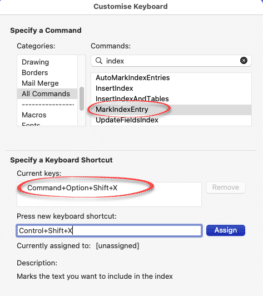
If you think that shortcut is clumsy (we do), try changing it to Control + Shift + X . That’s the closest we could get to the Winword shortcut (Alt+Shift+X isn’t possible in Word for Mac).
Show all
After marking an index entry, you will notice that the show hidden text and show all character options have both been enabled by Word. That’s so you can see and find index entries.

{XE} is the Word field code for Index Entry.
In the double-quotes is the index label. Each sub-level is separated by a colon e.g. “Dr Watson:Revolver” is the Main and Sub entry.
b is the switch to add Bold formatting to that index entry. We’ll look at other switches later.
Create a simple Index in Word
Now there’s a few index entries in the document, let’s make an index from them.
Click the cursor at the end of your document (or wherever you want your index to appear), then navigate to “Reference | Index | Insert Index”

The Index dialog gives you a number of formatting options. The current formatting settings are displayed in the “Preview” pane.
Type: Indented or Run-in
The “Type” radio-button allows you to specify either an “Indented” or “Run-in” type of hierarchical display. You’ve already seen the common Indented index, here’s the run-in alternative:

Run-in takes less vertical space than Indented.
Columns
Another way to save space with an index is adding columns.
The “Columns” box allows you to specify the number of columns that the index will be displayed on per page. It’s much the same as Word’s normal multi-column support but lacks some of the column formatting choices.

The columns can be adjusted from the ruler. If you want better column control (like vertical lines between columns), try inserting multiple columns from the Layout tab then putting a single column index inside the multi-column section.
Right align page numbers
“Right align page numbers” checkbox gives more of a “Table of Contents” look to the index.
Tab leader are the characters between the entry and page number, they guide the eye along the line.

Index Formats
The “Formats” drop down box gives you a number of pre-defined styles to choose from that can be seen in the preview pane. The available styles haven’t changed much over the years, in Word 365 are:
- From template
- Classic
- Fancy
- Modern
- Bulleted
- Formal
- Simple
To design a custom style click the “Modify” button, choose a style and customize as you see fit.
When you are happy with your index layout as it appears in the preview pane, click the “OK” button and your index will be displayed in all its glory.
If you have made any changes to your index entries, always remember to click anywhere on your index and press F9 for those changes to appear in the index itself. Or right-click then Update Field.
That’s enough to get you started. In future articles we’ll look at the many hidden options in Word’s indexing plus some of its shortcomings.
Outlook is stopping Windows Indexing and how to fix it
How to STOP a specific document from being searched / indexed?
Match and Index lookup in Excel
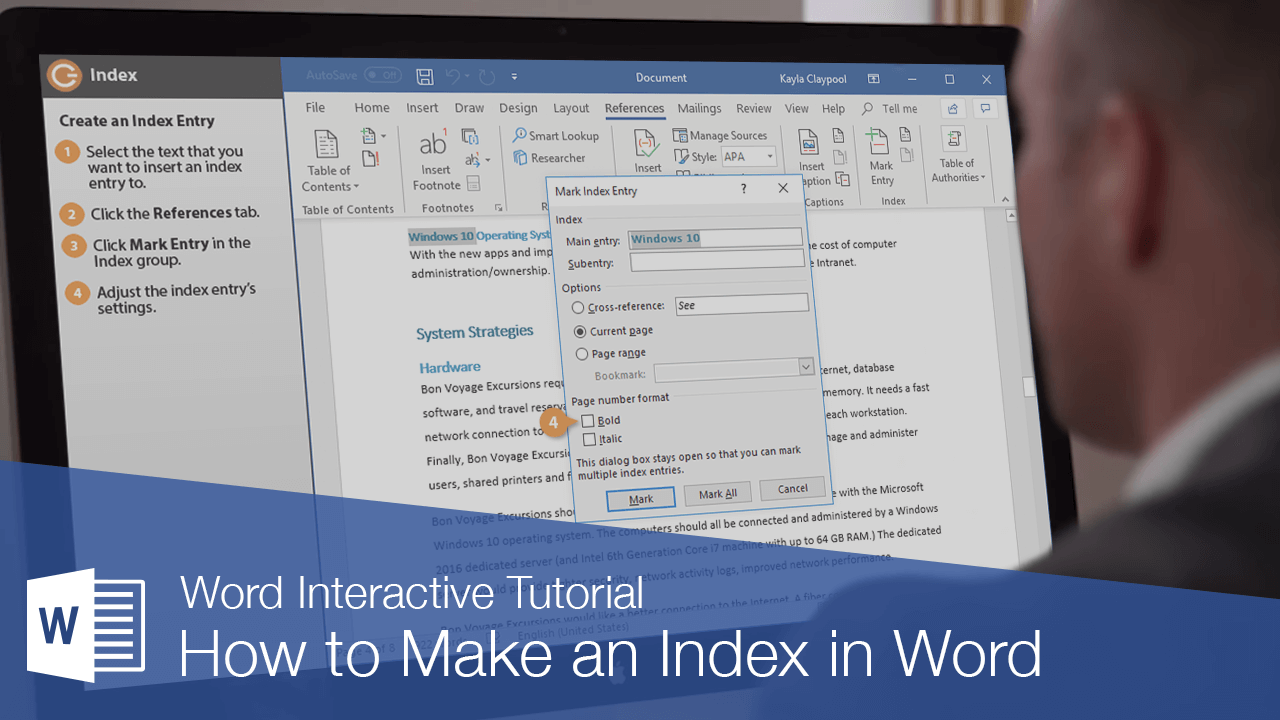
An index can usually be found at the end of a document, listing the key words and phrases in a document, along with the page numbers they appear on. There are two steps involved in creating an index: defining which words you want to appear in the index and then inserting the index.
Insert an Index Entry
- Select the text you want to include in the index.
- Click the References tab.
- Click the Mark Entry in the Index group.
- Adjust the index entry’s settings and choose an index entry option:
- Cross-reference: Adds a reference to another index entry, instead of listing the current page number.
- Current page: Lists the current page number for the selected index entry. This is the default option.
- Page range: Lists the range of pages that are included in the bookmark that you click in the Bookmark list. Before using this option, you’ll need to create a bookmark of the selected range.
- Click the Mark or Mark All button.
- Repeat the process for your other index entries.
- Click Close when you’re done.
The Mark Index Entry dialog box opens, where you can set up how the index entry works. The main entry field is filled with the selected text, and you can also add a subentry that will appear below the main entry.
Clicking Mark will create an index entry for the selected instance of the word. Clicking Mark All will instead create an index entry for every instance of the selected word throughout the document.
Once you mark an entry, formatting marks will be displayed so that you can see the hidden text that marks index entries. The window remains open, so you can continue to mark index entries throughout the document.
Index entries are invisible and will not be printed. However, you can see them when the paragraph marks are turned on.
Insert an Index
Once index entries have been marked, you’re ready to insert the index.
- Click in your document where you want to insert an index.
- Click the Insert Index button on the References tab.
- Customize the appearance and behavior of the index.
- Click OK.
Indexes usually appear at the end of a document and can take up a lot of space, so a blank page at the end is ideal.
The Index dialog box opens, where you can set up how the index will appear.
You can choose whether to right align page numbers and select a tab leader that appears between text and page numbers. You can also select whether to use a document’s formatting theme or select another one.
You can choose whether subentries will be indented below the main entry or shown run-in style in a paragraph below the main entry.
Any changes you make to the index appearance will be shown in the Print Preview.
The index is inserted, automatically filling itself out with all the index entries in the document.
Update an Index
When you insert an index, it automatically adds every index entry in the document. If you add or modify index entries after the index is created, you’ll need to update the index.
- Click anywhere in the index.
- Click the Update button.
The index is updated, adding any newly created entries while updating the page numbers for any entries that may have moved.
FREE Quick Reference
Click to Download
Free to distribute with our compliments; we hope you will consider our paid training.
An index offers readers a way to easily find important words in our document, but creating an index by hand is very tedious and time consuming. Fortunately, can automatically create index table in Word.
Picture of Ifijay
The common approach to creating an index table in Word is to manually mark every word that we crave to index, but the other alternative is to use a concordance document to automatically index our master document, what we will cover in today’s post.
Generating the index
Let’s start by creating a two column table in our concordance file. Write the words you would like to be flagged for indexing in the left column. Write the text you would like to use in the index table of the master document in the right column.
Close the concordance file and open the reference tab of your master document to index our master document.
Click the button “AutoMark” and choose the matching document when word prompts you to specify the automark file.
Immediately after clicking the OK button, you will see that Word creates some index entry fields in our document.
We can hide these fields by clicking on the “Show / Hide paragraph” on the home tab.
Go to the end of the master document and click the “Insert Index” once again and click the OK button this time to create the index.
That’s all we have on how to create an index table with a concordance file. Let’s take a closer look at how we can customize the index style.
Cross-reference the index
Word allows us to create different types of indexes. Here we have a subentry index that is particularly useful when we want to group a set of closely related concepts in our document.
The trick to creating a subentry is to separate the text in the right column of our match documents table with a colon (:). Word will treat any word that comes after the colon as a subentry in the index.
Another useful type of index is a cross-reference index that generally comes in the form of “See also …”
Unfortunately, we can’t cross-reference our index table using a match file, so we have to manually edit the index field by adding ” t” after the indexed word followed by the cross-reference word.
Keep index
One of the challenges of maintaining an index in Word is that Word doesn’t give us a button or menu that we can simply click to remove the fields from the index if we decide to redo our concordance file..
We have to use a Visual Basic script to remove the index fields in our document. Most of you must be thinking «Visual Basic Script, I’m not a programmer! What’s that ?”. Do not worry, it’s not as bad as it seems. Just copy and paste this simple script written by the amazing guys at TechRepublic in Word’s Visual Basic editor and run it to clean up the index fields of your master document.
Sub DeleteIndexEntries()
Dim doc As Document
Dim fld As Field
Set doc = ActiveDocument
For Each fld In doc.Fields
fld.Select
If fld.Type = wdFieldIndexEntry Then
fld.Delete
End If
Next
Set fld = Nothing
Set doc = Nothing
End Sub
Open the Visual Basic editor by pressing Alt + F11 and put this script in the editor. Run the script by clicking the “run button” to clean the index fields of the master document.
Your master document should no longer have index fields. Now we can re-index the master document and recreate the index table using the menu “Insert Index”.
Apply different index table formats
Yes, the index is definitely useful for your reader, but most likely some of you are thinking, «Why does the index table look so boring? Can I change the appearance to make it more attractive? ”. The solution is Yes, The index table doesn’t have to look simple.
We can adjust the style of the index table by selecting one of the available formats to adjust the appearance of the index table.
Below is an example of how Classic the index format looks like.
We can even apply our own style to the index table by choosing “From template” and clicking the “Modify”.
Choose one of the available index styles and click the “Modify” to create our own style.
We can adjust the font style of the index table.
Give the index table some borders or numbering;
… To give the index table a specific look and feel.
That’s all we have to create an index table with Microsoft Word. Have more great tips for document building? Share your experience in the comments.
Once you have built your Word Index using the Mark and Index method or by using a concordance, use the following 14 switches to control what information appears in the index and how it should look.
Press Alt F9 to display all field codes in a document. Or right-click any field entry to toggle a single field code on or off.
You should place the required switches inside the braces of the INDEX field code like this: { INDEX [switches go here] }.
b Bookmarkname
The b switch builds an index for a section of bookmarked text.
To bookmark a section of text, first select the text, then click Insert | Bookmark, type a bookmark name (spaces not allowed) and click OK.
The bookmark name is not enclosed with quotes.
Example: { INDEX b Chapter1 } builds an index for the section of text as identified by the bookmark Chapter 1.
c NumberOfColumns
The c switch creates an index with the specified number of columns, up to 4.
The number of columns is not enclosed with quotes.
Example: { INDEX c 2 } creates a two-column index.
d «SeqPageSeparators»
Used in combination with the s switch, the d switch specifies the separator character(s) (up to five) that separate sequence numbers (generated using the SEQ field in the same document or a subdocument) from page numbers.
A hyphen (-) is used if you omit the d switch.
Do not enclose the sequence number for the s switch in quotes but DO enclose the separator characters for the d switch in quotes.
Example: { INDEX s Chapter d » : » } displays page numbers in the format «6:18» where «6» is the SEQ identifier named «Chapter» and «18» is the page number.
Example: { INDEX s Chapter d » —» } displays page numbers in the format «6—18»
e «EntryPageSeparators»
The e switch specifies the characters (up to five) that separate an index entry and its page number. The default separator is a comma and space («, «).
Enclose the separator characters in quotes.
Example 1: { INDEX e » — » } displays «Marked text entry — 3»
Example 2: { INDEX e } displays «Marked text entry, 3»
f «Identifier»
The f switch creates an index using only the specified identifier.
The default identifier is «I».
Identifiers must be single characters and enclose in quotes.
Example: { INDEX f «a» } only includes entries marked with XE fields such as { XE «Marked text» f «a» }, while { INDEX f «b» } only includes entries with XE fields such as as { XE «Marked text» f «b» }.
g «PageRangeSeparators»
The g switch specifies the characters (up to five) that are placed between the first and last page numbers in a range. The default is a hyphen (-).
Enclose the separator characters in quotes.
Example 1: { INDEX g » to » } displays «Marked index entry, 3 to 4».
Example 2: { INDEX g » … » } displays «Marked index entry, 3 … 4».
h «AlphabeticHeader»
The h switch formats the alphabetic index header (e.g. A, B, C etc.). This text uses the Index Heading style.
Enclose the text in quotes.
Example 1: { INDEX h «-A-» } displays the appropriate letter before each alphabetic group in the index, resulting in:
-A-
Abacus, 1
Apple, 2
-B-
Banana, 3
Boatie McBoatface, 4
etc.
Example 2: { INDEX h » » } or { INDEX h » » } places an empty line between each alphabetic group, resulting in:
Abacus, 1
Apple, 2
Banana, 3
Boatie McBoatface, 4
etc.
k «CrossRefSeparators»
The k switch defines the separators (up to five) between cross references and other entries.
Enclose the separator character(s) in quotes.
l «PageNumSeparators»
The l switch specifies the characters (up to five) that separate multiple-page references. The default separator is a comma and a space (, )
Enclose the separator character(s) in quotes.
Example 1: { INDEX l » or » } displays entries such as «Marked text entry, 23 or 45 or 66».
Example 2: { INDEX } displays entries such as «Marked text entry, 23, 45, 66».
p «SelectedAlphaRange»
The p switch compiles a partial index for the specified letters.
Use an exclamation mark (!) to include entries that begin with characters other than letters such as #, ~ or *.
Example 1: { INDEX p a-m } generates an index for only the letters A through M
Example 2: { INDEX p n-z } generates an index for only the letters N through Z.
Example 3: { INDEX p !—m } includes any special characters, as well as the letters A through M.
r
The r switch runs subentries into the same line as the main entry
Colons (:) separate main entries from subentries.
Semicolons (;) separate subentries from each other.
Example 1: { INDEX r } displays entries such as
Printing: selected text 2; page range 3; entire document 4.
Example 2: { INDEX } displays
Printing
selected text 2
page range 3
entire document 4.
s «SEQname»
The s switch includes the sequence number with the page number.
The default separator character between the sequence number and the page number is a hyphen (-).
Use the d switch to specify a different separator character.
The SEQ name must be enclosed in quotes.
y
The y switch enables the use of yogi text for index entries
z
The z switch defines the language ID that Microsoft Word uses to generate the index
So, how will you use Index switches?
Create or edit an index
Word automates most of the work involved in creating an index and enables you to easily make updates or apply formatting changes. To create an index, you must first mark the entries you want to include, and then build the index.
Mark the entries
-
Select the text you want to use as an index entry.
-
Click References > Mark Entry.
-
In the Mark Index Entry dialog box, you can edit the entry or add a second level in Subentry. If you need a third level, follow the subentry text with a colon.
-
To create a cross-reference to another entry, click Cross-reference under Options, and then type the text for the other entry in the box.
-
To format the page numbers that will appear in the index, under Page number format, select Bold or Italic .
-
Click Mark to mark the index entry. To mark this text everywhere it shows up in the document, click Mark All.
-
Click Close.
-
Repeat steps 1 — 7 until you’ve marked all of the entries you want in the index.
Create the index
After you mark the entries, you can insert the index into your document.
-
Click where you want to add the index.
-
Click References > Insert Index.
-
In the Index dialog box, you can choose the format for text entries, page numbers, tabs, and other characters.
You can also change the overall look of the index by choosing one of the options under Formats. When you choose an option, you’ll see a preview in the box to right.
-
Click OK.
Note: If you mark more entries after you create the index. you’ll need to update the index to the new entries. Click References > Update Index.
Step 1: Mark the entries
You can create an index entry for a specific word, phrase, or symbol, or for a topic that spans a range of pages.
Mark index entries for words or phrases
-
Select the text that you want to use as an index entry.
-
On the Insert menu, click Index and Tables.
-
On the Index tab, click Mark Entry.
Tip: To go directly to the Mark Index Entry dialog box, press
+ OPTION + SHIFT + X .
-
Type or edit the text in the Main entry box.
Tips:
-
To create a subentry, specify the main index entry, and then type the subentry in the Subentry box.
-
To create a third-level entry, type the subentry text followed by a colon (:) and the text of the third-level entry.
-
-
Do one of the following:
To mark
Click
The index entry
Mark
The first occurrence of this text in each paragraph in the document that exactly matches the uppercase and lowercase letters in the entry
Mark All
Tip: To mark index entries for symbols such as @, in the Main entry box, immediately following the symbol, type ;# (semicolon followed by the number sign), and then click Mark. When you build the index, Word puts the symbols at the beginning of the index.
-
To mark additional index entries, select the text or click immediately after it, click in the Mark Index Entry dialog box, and then repeat steps 4 and 5.
Note: Word inserts each marked index entry as an XE (Index Entry) field in hidden text format. If you do not see the XE field, click Show/Hide
on the Standard toolbar.
Mark index entries for text that spans a range of pages
-
Select the range of text that you want the index entry to refer to.
-
On the Insert menu, click Bookmark.
-
In the Bookmark name box, type a name, and then click Add.
Note: Do not include spaces in the bookmark name.
-
In the document, click at the beginning of the range of text that you selected.
-
On the Insert menu, click Index and Tables.
-
On the Index tab, click Mark Entry.
-
In the Main entry box, type the index entry for the marked text.
-
Under Options, click Page range.
-
In the Bookmark box, type or select the bookmark name that you typed in step 3.
-
Click Mark
-
Click Close.
Note: Word inserts each marked index entry as an XE (Index Entry) field in hidden text format. If you do not see the XE field, click Show/Hide
on the Standard toolbar.
Step 2: Edit or delete index entries (optional)
If you change the index entries in the finished index, Word deletes your changes the next time that you rebuild the index. To permanently keep your formatting changes, format the index entry fields in the document.
Edit an index entry
-
Edit the text inside the quotation marks.
Main entry
Cross reference
If you do not see the XE (Index Entry) fields, click Show/Hide
on the Standard toolbar.
Delete an index entry
-
Select the whole index entry field, including the braces {}, and then press DELETE .
If you do not see the XE (Index Entry) fields, click Show/Hide
on the Standard toolbar.
Step 3: Design and build the index
After you create the index entries, you can build the index in your document. An index typically appears at or near the end of a document. However, you can insert the index anywhere in the document.
Caution: To make sure that the document is paginated correctly, hide field codes and hidden text before you build your index. If the XE (Index Entry) fields are visible, on the Standard toolbar, click Show/Hide 
Build an index by using one of the supplied index designs
-
Click in your document where you want to insert the finished index.
-
On the Insert menu, click Index and Tables, and then click the Index tab.
-
In the Formats box, click a design.
-
Select any other index options that you want.
Build an index by using a custom index design
-
Click in your document where you want to insert the finished index.
-
On the Insert menu, click Index and Tables, and then click the Index tab.
-
In the Formats box, click From template, and then click Modify.
-
Click a style in the Styles box, click Modify, and then apply any formatting that you want.
-
Select any other index options that you want.
See also
Create a table of contents

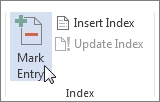
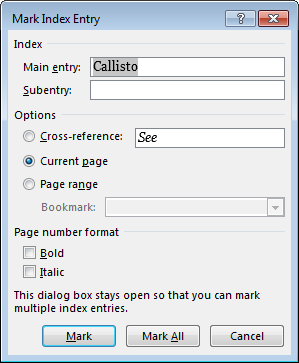
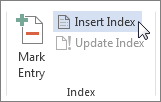
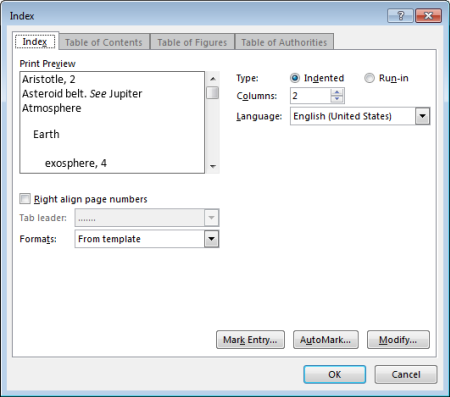
 in the Paragraph group on the Home tab.
in the Paragraph group on the Home tab.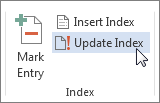
























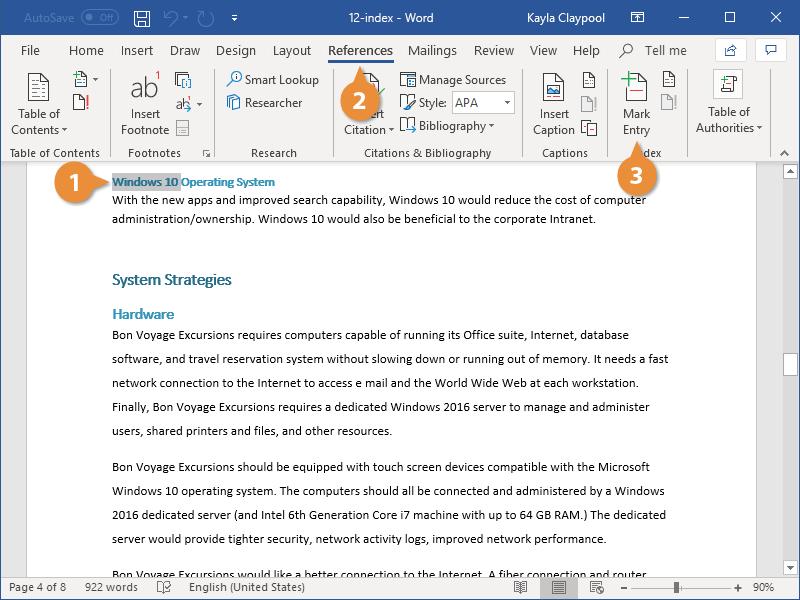
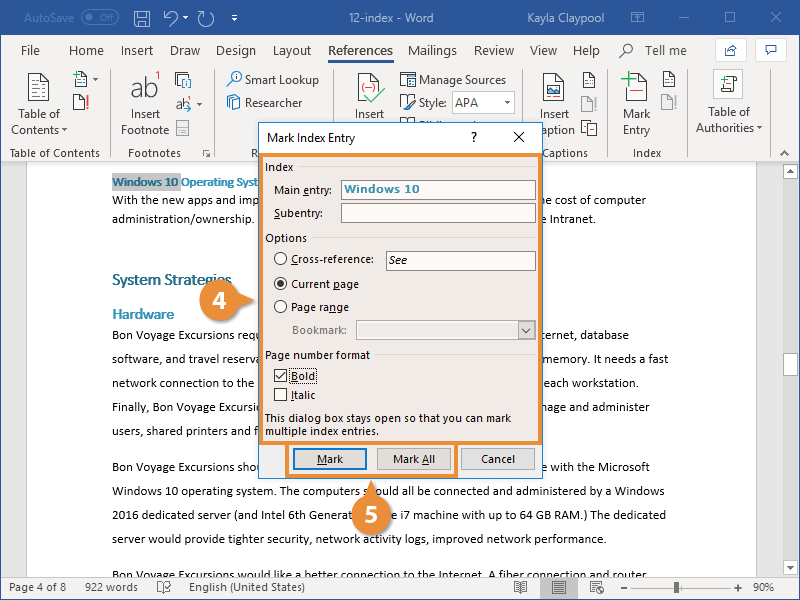
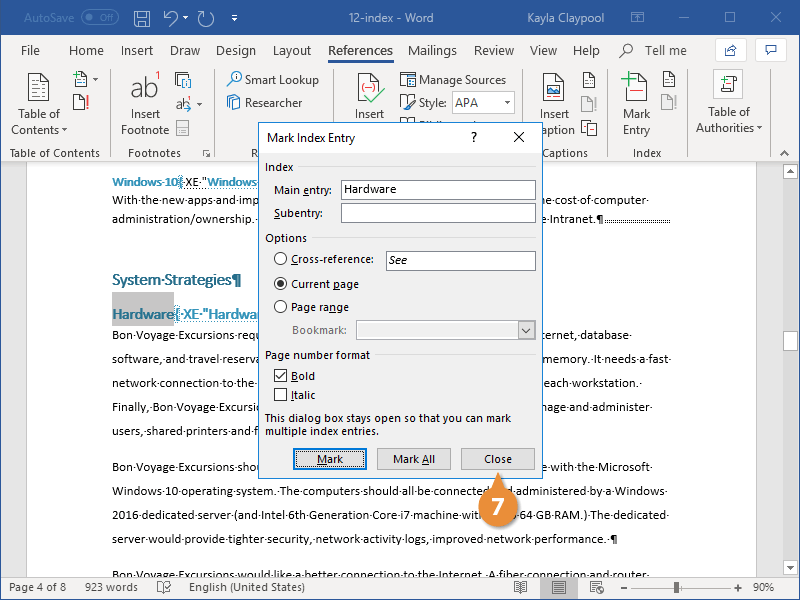
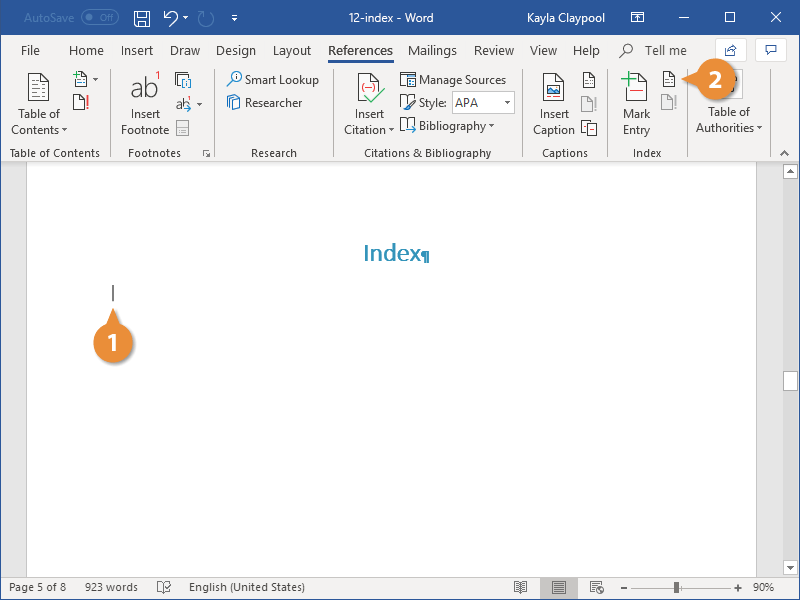
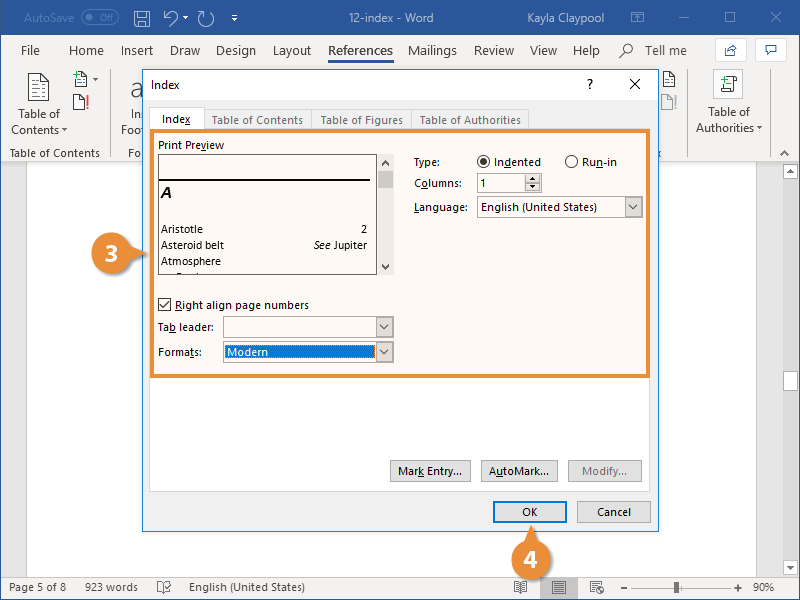
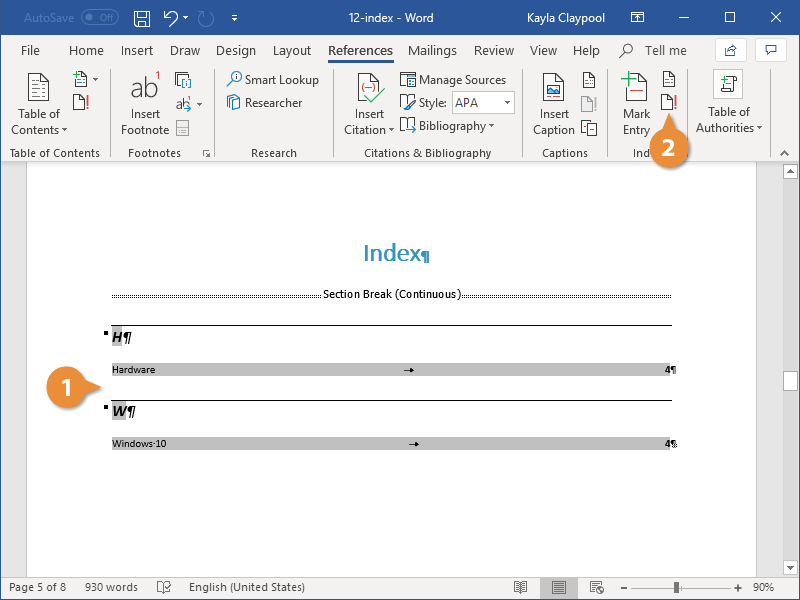















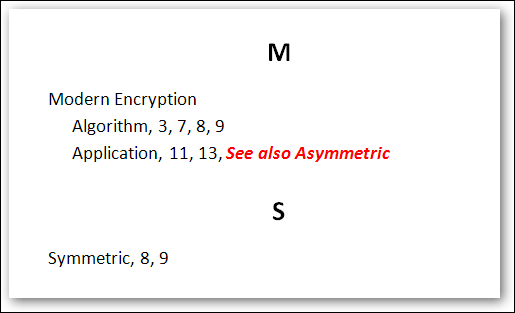






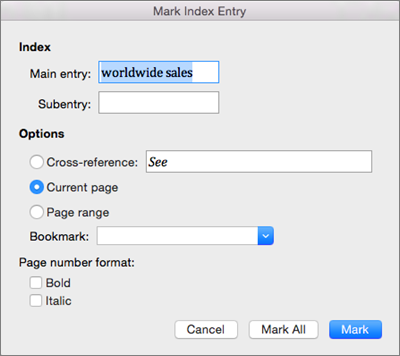

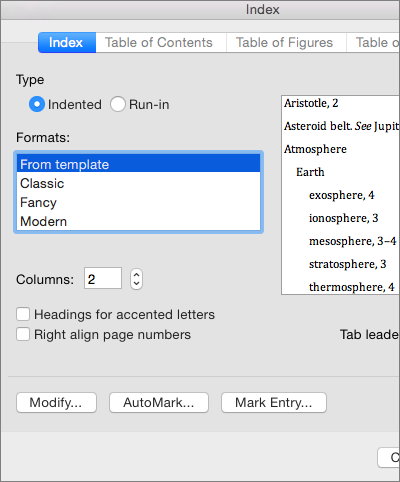
 + OPTION + SHIFT + X .
+ OPTION + SHIFT + X .
 Main entry
Main entry Cross reference
Cross reference